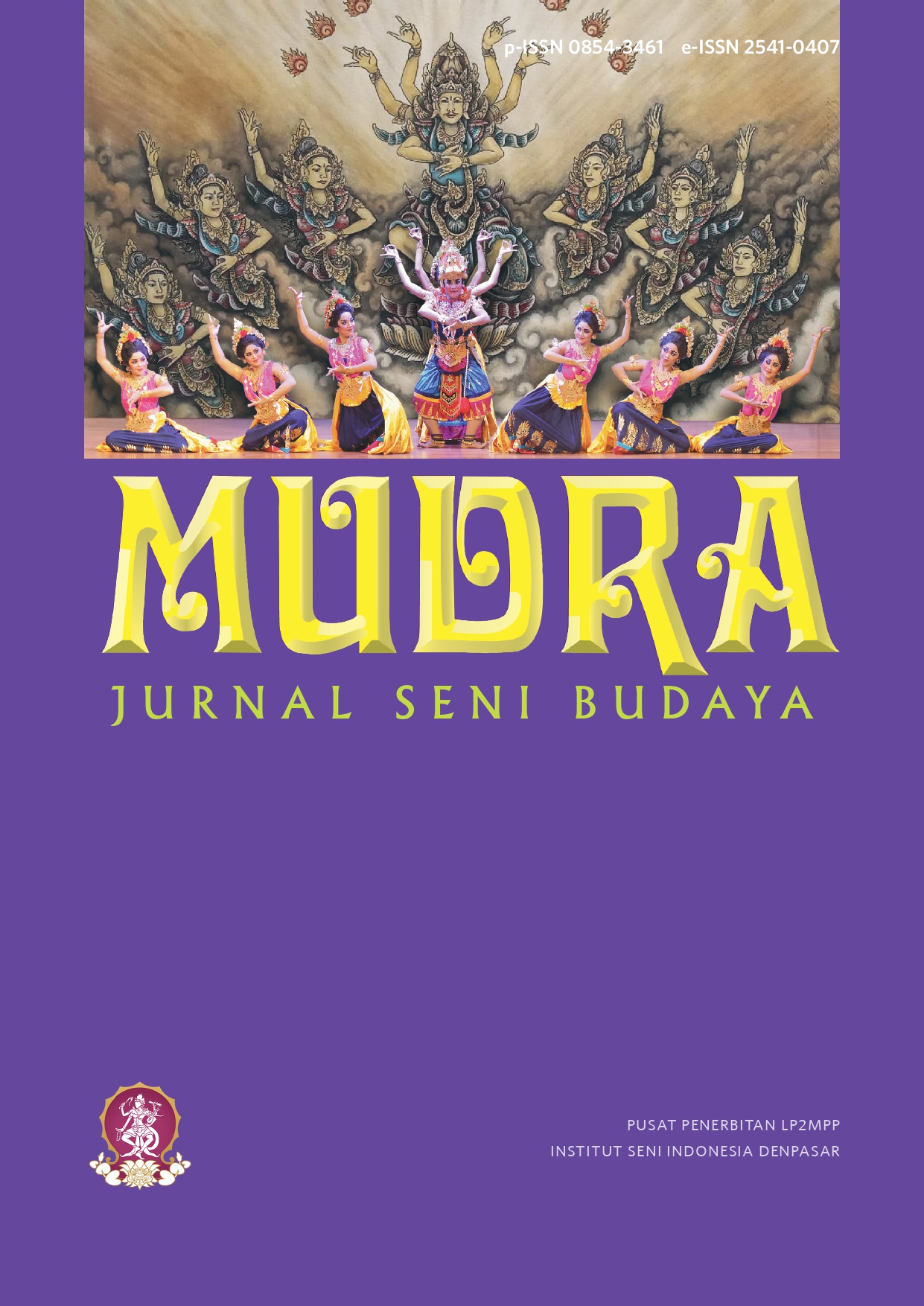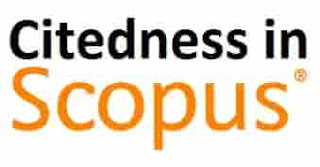The Inscription of Word Gempeng and 899 as Petirtaan Jolotundo’s Cultural Identity
DOI:
https://doi.org/10.31091/mudra.v40i3.2914Keywords:
Inscription, Petirtaan Jolotundo, Gempeng, Cultural IdentityAbstract
Petirtaan Jolotundo is one of two petirtaans (sacred bathing places) on Mount Penanggungan. It is an important archaeological heritage site, known for having the oldest recorded date in the Penanggungan Mountain area—899 Saka or 977 AD. Within the petirtaan is an inscription carved on its eastern wall, visually prominent and written in Old Javanese (Kawi) script, containing the word Gempeng and the number 899. This research aims to uncover Petirtaan Jolotundo's cultural identity through the interpretation of these two inscriptions. The study was conducted at the site of Petirtaan Jolotundo, located in Biting Hamlet, Seloliman Village, Trawas District, Mojokerto Regency, East Java Province. This qualitative research adopts a case study approach, focusing specifically on Petirtaan Jolotundo. Data collection techniques include observation, literature review, and interviews. The data analysis method follows an interpretative qualitative approach, applying Norman Fairclough's theory of critical discourse analysis, which comprises three levels: textual analysis, discursive practice, and social practice. The results of this study show that the inscriptions—Gempeng and 899—serve as cultural markers that reveal the identity of Petirtaan Jolotundo and the Old Javanese community. These inscriptions highlight the community's role in shaping and preserving the site's cultural significance across generations.References
D. Chihara, Hindu-Buddhist architecture in Southeast Asia. in Studies in Asian art and archaeology, no. v. 19. Leiden ; New York: E.J. Brill, 1996.
S. Kramrisch, The Art Of Nepal. The Asia Society, 1964. Accessed: May 26, 2025. [Online]. Available: https://www.abebooks.co.uk/Art-Nepal-Stella-Kramrisch-Asia-Society/32083146702/bd
A. A. Munandar, Gajah Mada Biografi Politik, Cetakan Pertama. Jakarta: Komunitas Bambu, 2010.
L. Kieven, Following the Cap-figure in Majapahit Temple Reliefs: A New Look at the Religious Function of East Javanese Temples, Fourteenth and Fifteenth Centuries. Brill, 2013.
N. Fairclough, Critical Discourse Analysis: The Critical Study of Language, 2. ed., [Nachdr.]. London: Routledge, 2013.[6] T. Eaude, Identity, Culture and Belonging: Educating Young Children for a Changing World. London: Bloomsbury Publishing Plc, 2020.
I. P. G. Suwitha, “Identity and Ethnicity of Bugis Community in Bali: An Historical Perspective,” Paramita Hist. Stud. J., vol. 27, no. 2, pp. 141–153, 2017.
S. Sutiyono and B. Suharjana, “Community identity politics of Brijo Lor society, Klaten in Ki Ageng Glego myth through Reog performance,” Harmon. J. Arts Res. Educ., vol. 17, no. 2, pp. 144–152, 2017.
L. Riamei, The Kurdish Question: Identity, Representation and the Struggle for Self- Determination: Identity, Representation and the Struggle for Self- Determination. India: KW Publishers Pvt Ltd, 2015.
M. Ennaji, Multilingualism, Cultural Identity, and Education in Morocco. Springer Science & Business Media, 2005.[11] D. G. Puspitasari, S. Sabana, and H. A. Ahmad, “The Cultural Identity of Nusantara in a Movie Entitled Sang Pencerah by Hanung Bramantyo,” Harmon. J. Arts Res. Educ., vol. 16, no. 1, pp. 57–65, 2016.
C. P. P. Purba, “Understanding Cultural Diversity and Diverse Identities,” UNCLLE Undergrad. Conf. Lang. Lit. Cult., vol. 3, no. 1, Art. no. 1, Jul. 2023.
A. A. P. Dwipayana, “Makna Perubahan Identitas Desa Adat di Tengah Pembangunan Pariwisata Budaya di Bali,” J. Ilmu Sos. Dan Hum., vol. 12, no. 2, pp. 322–331, 2023.
J. Kupiainen, E. Sevänen, and J. Stotesbury, Cultural Identity in Transition: Contemporary Conditions, Practices and Politics of a Global Phenomenon. Atlantic Publishers & Dist, 2004.
C. G. Voicu, Exploring Cultural Identities in Jean Rhys' Fiction. De Gruyter Open, 2014. doi: 10.2478/9788376560687.
P. Pujiati, A. Lundeto, and I. Trianto, "Representing Arab-Indonesian identity: Language and cultural narratives on social media," Indones. J. Appl. Linguist., vol. 14, no. 3, Art. no. 3, Jan. 2025, doi: 10.17509/ijal.v14i3.78286.
E. Munfarida, "Analisis Wacana Kritis dalam Perspektif Norman Fairclough," KOMUNIKA J. Dakwah Dan Komun., vol. 8, no. 1, pp. 1-19, 2014.
N. A. G. Al-Zubaidi and M. A. Al-Bazzaz, Iraqi Christian Minority and Identity: A Critical Discourse Analysis of Selected English and Arabic Novels. Germany: Grin Academic Publishing, 2023.
Z. R. Pohan, "LITERACY AND IDENTITY: FROM LIM KIM HOK, AND KHO PING HO TO THE CONTEMPORARY INDONESIAN LITERATURE," Lakon J. Kaji. Sastra Dan Budaya, vol. 10, no. 2, Art. no. 2, Nov. 2021, doi: 10.20473/lakon.v10i2.21526.
Abd. Ghofur, J. T. Ibrahim. A. In'am, and A. Nurjaman, Kritik dan Interpretasi Teks Inagurasi Trump : Analisis Wacana Kritis Bahasa, Kekuasaan, dan Ideologi, Cetakan Pertama. Bantul: Jejak Pustaka, 2023.
S. Rafiah, “Understanding CDA: Histories, Remembering, And Futures,” Scr. J. J. Linguist. Engl. Teach., vol. 3, no. 2, pp. 175–182, 2018.
R. Prayogi, Media, Wacana, Korupsi, dan Analisis Wacana Kritis Norman Fairclough: Teori dan Aplikasi Analisis Wacana Korupsi dalam Situs Indonesiana, Edisi pertama. Yogyakarta: Selat Media, 2023.
S. Sulistio, S. Suryanto, A. Hadziq, and S. Bulut, “The mediating effect of group identity and religious fundamentalism on the association of intergroup contact with prejudice,” Psikohumaniora J. Penelit. Psikol., vol. 5, no. 2, pp. 169–184, 2020.
T. A. Soenarto, Candi Jalatunda dan Pemugarannya. Jawa Timur: Bagian Proyek Pembinaan Peninggalan Sejarah dan Purbakala, 1995. Accessed: May 27, 2025. [Online]. Available: //pustakabbsulsel.kemdikbud.go.id%2Fbulian%2Findex.php%3Fp%3Dshow_detail%26id%3D5717%26keywords%3D
F. D. K. Bosch, "The Oldjavanese Bathing-Place Jalatunda," in Selected Studies in Indonesian Archaeology, Dordrecht: Springer Netherlands, 1961, pp. 47-107. doi: 10.1007/978-94-017-6006-5_3.
J. Flowerdew and J. E. Richardson, Eds., The Routledge Handbook of Critical Discourse Studies, First issued in paperback. in Routledge handbooks in applied linguistics. London New York: Routledge, Taylor & Francis Group, 2020.
N. Fairclough, Analysing Discourse: Textual Analysis for Social Research. London ; New York: Routledge, 2003.
N. R. H. Septiana and H. Septiana, RADIKALISME DALAM PERSPEKTIF ANALISIS WACANA KRITIS. Graniti, 2019.
N. Fairclough, “Critical Discourse Analysis and the Marketization of Public Discourse: The Universities,” Discourse Soc., vol. 4, no. 2, pp. 133–168, Apr. 1993, doi: 10.1177/0957926593004002002.
H. Diha, A. Wahab, and Z. Zulkarnain, “Questioning power and identity: Race and class in Tambora 1815 by Paox Iben Mudhaffar,” LITE J. Bhs. Sastra Dan Budaya, vol. 21, no. 1, pp. 68–79, Mar. 2025, doi: 10.33633/lite.v21i1.11824.
J. Blommaert, J. Collins, and S. Slembrouck, "Polycentricity and interactional regimes in 'global neighborhoods,'" Ethnography, vol. 6, no. 2, pp. 205-235, Jun. 2005, dot: 10.1177/1466138105057557.
J. Blommaert, “Sociolinguistics and Discourse Analysis: Orders of Indexicality and Polycentricity,” J. Multicult. Discourses, vol. 2, no. 2, pp. 115–130, Nov. 2007, doi: 10.2167/md089.0.
K. Tamtomo, “The compartmentalization of languages and identities among nationalist youth in Semarang,” Wacana, vol. 19, no. 1, pp. 168–190, 2018.
M. Qadaruddin and W. Bakri, Islam Media Sosial dan Generasi Postmilenial. Deepublish Digital, 2023. Accessed: May 27, 2025. [Online]. Available: https://digilib.uinsyahada.ac.id/detail/islam--media-sosial-dan-generasi-postmilenial/79760
A. A. Munandar, "Hubungan Bali dan Jawa Timur : Kajian Terhadap Arsitektur Keagamaan Dalam Abad 10-11 Masehi," in Pertemuan Ilmiah Arkeologi VII, in Jilid V. , Jakarta: Proyek Penelitian Arkeolog Jakarta, 1998.
J. B. Abdillah, T. Prabasmoro, and D. Mahzuni, “Community identity construction: A case study of digital literacy activists in Next Generation Indonesia Community,” Satwika Kaji. Ilmu Budaya Dan Perubahan Sos., vol. 9, no. 1, pp. 128–139, 2025.
A. I. Obos, B. Suhatmady, and Y. U. Asih, “Nadiem Makarim’s Speech: A Critical Discourse Analysis at National Education Day,” Scr. J. J. Linguist. Engl. Teach., vol. 7, no. 2, Art. no. 2, Oct. 2022, doi: 10.24903/sj.v7i2.1024.
Downloads
Published
How to Cite
Issue
Section
License
Copyright (c) 2025 Lauhil Fatihah Lauhil Fatihah, Edi Dwi Riyanto

This work is licensed under a Creative Commons Attribution-NonCommercial-ShareAlike 4.0 International License.
- Copyright on any open access article in a journal published by Mudra Jurnal Seni Budaya is retained by the author(s).
-
The Creative Commons Attribution License 4.0 formalizes these and other terms and conditions of publishing articles.










